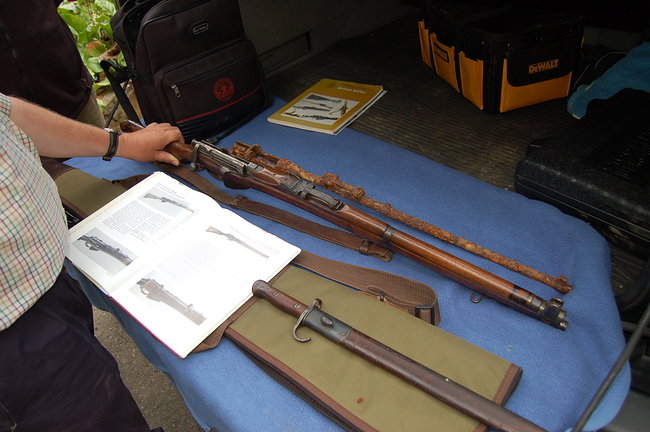Last night I met a very knowledgable chap from the Firearms Council (who also happens to be called David). He visited the house to see the bunker, and brought with him his very rare early Lee Enfield Mark 1 militia rifle, to use as comparison with the two weapons found in the tunnel.
Unfortunately we couldn't pick up the gun nearest the entrance as it has over the years become fused to the floor!

However David immediately recognised it as an early Mark 1 "long" gun, dating from the end of the 19th century. Apparently these were often used as sniping rifles during the first world war.

The weapon that was located further inside the tunnel we removed to make a direct comparison with the Mark 1 "short" gun that David had brought along. His particular gun is rare in that it had been specifically issued to the Island Militia. It had its original bayonet.



On the basis that the gun from the tunnel had a bridge (seen at the back of the breach), David concluded (as many others already have) that it was a Mark 3 Short Magazine Lee Enfield (SMLE), and that the stock had obviously at some stage been forcibly knocked off.




Dave was on hand to preside over proceedings.

I was also able to recount to the others a conversation I'd had earlier in the day with another member of the 1960's Tunnel clearance team (which I've already previously mentioned). On this occasion I managed to talk to a specialist diver who'd been a member of the crew. This man did have a clear recollection of visiting the site now occupied by my neighbours and my property in the 1960s. He said that the visit came about because of a rumour that the fence posts in the garden of the property were all made of old WW2 rifle barrels! (This happens to be a modern day piece of local folklore - one which David had heard before).
Anyway, when the diver and the team turned up, there apparently did indeed find about 40 to 50 wartime rifle barrels being used in the garden for fencing and these were collected up as part of the Island wide clear up.
He said that he were also told by the then lady owner of the neighbours house about a large wooden armoury that had existed at the property immediately after the war, which had been full of munitions. These had been removed and the wooden shed sold to a farmer.
He also recounted that they had checked the neighbour's tunnel while on site, and had been told by the then owner of another tunnel that had already been covered over. I asked him whether he was able to find anything out about this second tunnel and whether it was perhaps on my property. He said that the lady owner had told him the second tunnel had for a short time after the war been used to store the large amount of the guns collected up from the armoury, before they were moved again (by whom he wasn't sure) and the tunnel was then blocked up.
I asked if she had told him how it was blocked? Apparently she had explained to him that the gardener had put some beehives inside and then covered the entrance and made a rockery! Because of this, he said that his team didn't actually check behind the neighbours house in the area where my property is located. Instead they took the lady at her word that the tunnel was secure.
Finally he said that he had heard that an underground chamber had later been found that was full of mausers!
So what can be gleaned from this story? Well, I suppose the bee hive part of it could be said to check out - as we found a rotten old hive inside our tunnel! But, and this is a big but I think, I'm extremely sceptical about the suggestion that a gardener in the nineteen forties could have "covered the entrance with some rocks", after all, do you remember that huge boulder that we couldn't move with all our modern equipment? And the massive landscaping required to fill in the entrance road is hardly "making a rockery"?

There must be literally be hundreds, perhaps even thousands, of tons of rock spread out around on the northern face of the quarry which doesn't appear to be there in the wartime aerials. So....perhaps there is another similar sort of tunnel somewhere nearby on the neighbours land? Or perhaps the story about the gardener is wrong, afterall, it was recounted in the 1960s, perhaps not even by the owner who lived there imediately after the war?
And what about those Mausers? If I'm only hearing about their discovery now, I imagine they're long gone.







































